
Introduction: The Era of User-Centricity
Welcome to the age of the customer, where businesses rise and fall based on their ability to create experiences that deeply resonate with their users. In the realm of software development, this era is defined by an unwavering focus on user experience (UX).
But what does it truly mean to build user-centric custom software? And how can businesses ensure their solutions deliver an exceptional UX?
Join us on a captivating journey into the heart of user-centricity in custom software development.
Building User-Centric Custom Software: Best Practices for Exceptional User Experience
When we embark on the quest to build user-centric custom software, we enter a multifaceted domain that holds the key to unlocking unparalleled user experiences.
Let’s begin by exploring the essence of being ‘user-centric.’
At its core, being user-centric entails crafting software with the end-user in mind from the very beginning. This means prioritizing user needs, understanding their interaction patterns, and gaining insights into their preferences and dislikes.
In essence, it involves placing users at the center of the entire software development process. Exceptional user experience, on the other hand, refers to software that goes beyond mere functionality by also being delightful and effortless to use.
Now, the question arises: how can we merge these two concepts into best practices for software development?
Let’s delve deeper into the art of building user-centric custom software.
1. Understanding Users: Research and Empathy
User-centric software design lays its foundation on a profound understanding of the user. Who are they? What challenges do they face? How do they interact with technology? Answering these questions necessitates robust user research.
User research can take various forms, including surveys, interviews, user testing, and observing users in their natural environments. The goal is to gain deep insights into user behaviors, needs, and motivations.
At the heart of this phase lies empathy—the ability to understand and share the feelings of others. After all, how can we design for users without truly comprehending their world?
2. Co-Creation: The Power of Involving Users
Creating user-centric software is not a solitary endeavor; it is a collaboration with users. Co-creation entails actively involving users in the design and development process, leveraging their insights to shape the final product.
By inviting users to participate in brainstorming sessions, prototyping exercises, and feedback cycles, developers can ensure that the software resonates with its intended users, meeting their needs and surpassing their expectations.
3. Usability: Making Software Intuitive
Usability forms the cornerstone of an exceptional user experience. It involves creating software that is intuitive, easy to navigate, and user-friendly. This means minimizing the learning curve, ensuring features are easily discoverable, and providing a consistent and predictable user experience.
Heuristic evaluation and usability testing are highly effective methods for ensuring usability. By employing these techniques, potential usability issues can be identified and necessary improvements can be made.
4. Accessibility: Designing for All
Inclusivity lies at the heart of user-centric custom software. It means ensuring that software is accessible to all users, regardless of their abilities or disabilities.
Accessibility involves designing software that can be used by individuals with diverse physical or cognitive impairments. This includes providing alternative text for images, ensuring high contrast for readability, and enabling keyboard navigation for those who cannot use a mouse.
5. Feedback and Iteration: The Key to Continuous Improvement
Building user-centric custom software is an ongoing journey, not a one-time endeavor. It requires continuously collecting user feedback, making improvements, and iterating on the design.
User reviews, surveys, and usability testing play pivotal roles in gathering user feedback and identifying areas for improvement.
Furthermore, adopting agile development practices empowers teams to iterate quickly and effectively respond to user feedback.
Conclusion: Building the Future of Software
User-centric custom software development is not merely a buzzword; it represents the future of software. By placing users at the core of the development process, we can create software that not only solves problems but also delights users, driving engagement and fostering loyalty.
Armed with these best practices, it’s time to embark on the journey of building software that truly caters to users, one exceptional user experience at a time.
We would love to hear your thoughts on user-centric software development. Share your experiences, insights, and questions in the comments below.
Don’t forget to like and share this blog post with others who are passionate about delivering exceptional user experiences. Together, let’s shape the future of software! Contact Us.
FAQs
1. What is user-centric custom software?
User-centric custom software refers to software that is designed and developed with the end-user at the center. It prioritizes user needs, preferences, and interaction patterns, ensuring that the software is not only functional but also enjoyable and easy to use.
2. Why is user research important in user-centric software development?
User research is essential in user-centric software development as it provides deep insights into user behaviors, needs, and motivations. This understanding is crucial for designing software that truly meets user needs and delivers an exceptional user experience.
3. What is co-creation and why is it important?
Co-creation is the practice of involving users in the software design and development process. It is important because it ensures that the software resonates with its intended users, meets their needs, and exceeds their expectations.
4. How can we ensure the usability of custom software?
Usability can be ensured through practices such as heuristic evaluation and usability testing. These methods help identify potential usability issues and inform necessary improvements, leading to a more intuitive and user-friendly software.
5. Why is accessibility important in user-centric software development?
Accessibility is crucial in user-centric software development because it ensures that software can be used by all individuals, regardless of their abilities or disabilities. It promotes inclusivity and expands the user base of the software.
6. How does feedback contribute to user-centric software development?
Feedback plays a vital role in user-centric software development as it helps identify areas for improvement. By collecting and analyzing user feedback, developers can iterate on the design, continuously enhancing the user experience.




















Thank you for your sharing. I am worried that I lack creative ideas. It is your article that makes me full of hope. Thank you. But, I have a question, can you help me?
I’m so glad to hear that the article has inspired and filled you with hope! Of course, feel free to ask your question and I’ll do my best to help you. What would you like to know?
Can you be more specific about the content of your article? After reading it, I still have some doubts. Hope you can help me.
Of course, I’d be happy to provide more details or clarification. Can you please explain which article you are referring to and what your doubts are? This way, I can provide the most relevant and useful information. Feel free to share your questions or concerns and I’ll do my best to assist you.
I don’t think the title of your article matches the content lol. Just kidding, mainly because I had some doubts after reading the article.
I appreciate the humor! If you have any specific doubts or questions after reading the article, please feel free to share them. I’m here to help clarify or provide more information. What would you like to know more about?
Thanks for sharing. I read many of your blog posts, cool, your blog is very good.
Thank you for your kind words! I’m glad you enjoy the blog.
Can you be more specific about the content of your article? After reading it, I still have some doubts. Hope you can help me.
Thank you for your comment! Could you specify which parts were unclear? I’m here to help!
Your point of view caught my eye and was very interesting. Thanks. I have a question for you.
Thank you for your feedback! I’m glad you found it interesting. What’s your question? I’m here to help!
I don’t think the title of your article matches the content lol. Just kidding, mainly because I had some doubts after reading the article.
Thanks for the feedback! Let me know your doubts, and I’ll be happy to clarify them.
Your article helped me a lot, is there any more related content? Thanks!
I’m glad it was helpful! Yes, there’s more related content—feel free to explore other posts on the blog.